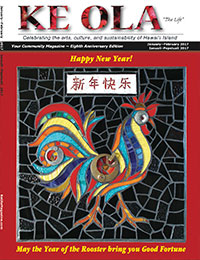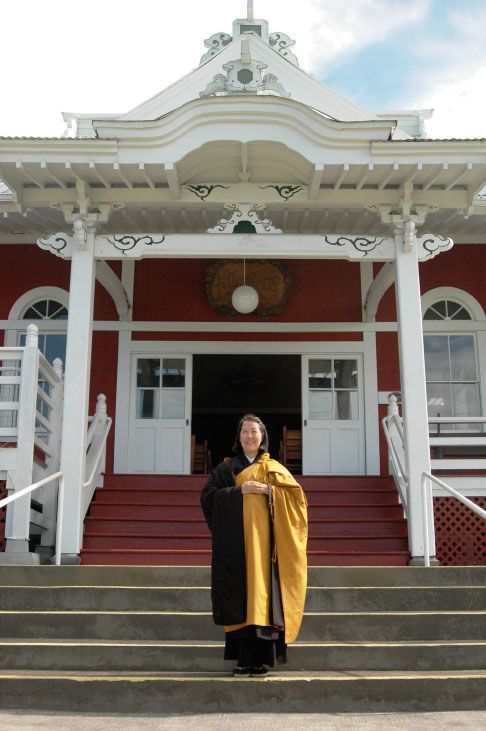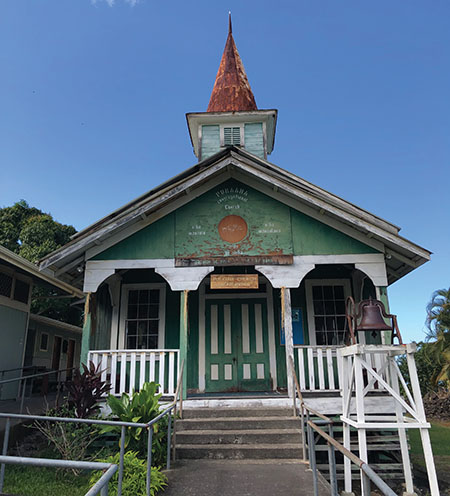
Queen Emma’s Church
 Kate Kealani H. Winter
Kate Kealani H. Winter
As visitors and locals hurry along the Hawai‘i Belt Road (Highway 11) near Kealakekua, they look mauka (toward the mountain) and see an old lava rock wall that seems to enclose a very old graveyard, and up the slope, a simple 150 year old gray church. A small sign down on the highway identifies it as Christ Church Episcopal.
Throughout 2017, the church celebrates its sesquicentennial, offering events that provide a view of its own history as well as Kona’s history and culture. The display of a new plaque points out that Queen Emma and King Kalākaua both worshipped there.
Behind the church itself is the modern Queen Emma Community Center that honors the church’s connection with Hawaiian royalty. By the 1860s, the English Anglican church that later became the American Episcopal Church was well-established in Honolulu. King Kalākaua, a confirmed Anglican, attended Christ Church while staying at Hulihe‘e Palace in Kailua-Kona. Later, Queen Emma went to services at the upcountry English-style church as well. When the Queen rode her horse the 15 miles mauka from Hulihe‘e Palace, her faithful subjects followed along or waited in a throng at the church. They filled it to overflowing, and many had to sit on the shaded steps or the grass outside.
Very few changes have been made to the structure in the past 150 years, because the church building itself is important for research into Hawaiian history and architecture. It is a rare, intact structure from its period and thus of great historical and cultural value.
Its story begins with the 1867 arrival at Kealakekua Bay of Charles Williamson, who had been educated at St. Augustine’s Missionary College in Canterbury, England. In addition to the classic education for Anglican ministry, he had studied carpentry and medicine. Once landed, Reverend Williamson began searching for a place to build the first Anglican church on the island. He finally found the perfect spot. At an elevation of about 1500 feet, cooler than down near the shore, warmer than higher up the slope of Hualālai, blessed with abundant sunshine and rain and an ocean view, as well as being situated on the only “highway” along the leeward side of the island. The land was owned by British businessmen engaged in the sugar industry, and it had been abandoned. The three owners “loaned” the young minister a two-acre parcel on which to build.

With almost no money, he himself began building. Within three months, with the help of two local carpenters, Williamson had built a church and a house where one room was arranged to be used as a school. The cost was slightly over $2000, most of that for lumber. With his own hands and back, he did at least a third of the work. During repairs more than 100 years later, a blue “W” was found painted on crossbeams and on one of the handmade pews, probably a mark from its builder and first minister.
The foundation is made up of low lava rock walls with ‘ōhi‘a logs for reinforcement. Douglas fir floors top that, and 5.5 inch tongue and groove Douglas fir covers the walls of the nave. Each single-hung window features a gothic arch. The structure was protected by a wood shingle roof held fast by square nails.
Before the church was even finished, Williamson held his first Hawaiian language service with 25 local natives attending. Sixty haoles (white people) attended the English service. On May 19, 1867, the first wedding was held for bride Pelieli‘i and groom Nakepalau. The church served as a spiritual home for native and haole alike, marking the important events in the peoples’ lives.
In just over two years, Williamson moved on. By then, Theo Davies was the only one of the original owners left, and since the land had been “loaned” to the young minister, ownership issues had to be negotiated.
Three years passed, and in 1872 the second vicar (minister) arrived: Samuel H. Davis. In the interim, the grounds had become choked with weeds and grass. Davis cleaned up and fenced off an area for a cemetery that would be consecrated two years later. The graves now spread down the hillside but leave plenty of room for another 150 years worth of stones and stories. Christ Church’s own coffee grove flourishes below the green expanse of the graveyard where headstones mark the histories of Kona. Historian and writer Maile Melrose gives lively walking tours of the cemetery, recounting the dramatic life and death stories that depict old Kona days.
Davis’ repairs to the original church included enclosing the steps leading into the church, affording protection from the rain and the sun. A corrugated metal roof was put on over the original shingles, and the spire was galvanized. Looking toward a long history of the church in Kona, Davis began the church’s endowment fund with the proceeds from the minister’s sale of homemade guava jelly. For the interior, he built the hexagonal baptismal font from a single piece of koa wood that is still used today.
Queen Emma’s well-known commitment to education for Hawaiian girls was supported by the church. Davis built a schoolhouse on the grounds, and his wife opened a boarding school for Hawaiian girls that offered “a sound English education.” Eventually it became a coed day school, and now a Hawaiian immersion school makes its home there.
Today you can touch the “plaster” on the exterior of the church, its sand and paint still mostly intact. Going into the old church now, visitors and parishioners cross the red carpet that provides a quieter walk to the altar than the bare floors did. The pews, however, still rest on the old fir floorboards. Vaulting across the nave and over the steps to the choir loft and altar is a dark arch bearing the verse, “Worship the Lord in the beauty of holiness.” In the 1980s, the church’s structural elements were “grandfathered,” but a ramp and rail were installed on the south side of the old church to make it welcoming to all.
Behind the altar and cross is a five-panel painting in oil. Some of its history is a mystery, but it is documented as a gift to the church and sent from Paddington, England in 1888. The three tall stained glass windows high above the painted panels—Jesus as a shepherd flanked by the sturdy pink of Queen Emma lilies that match the flowers growing around the grounds—blend images from traditional churches with particularly Hawaiian ones.
On the east wall rests a gleaming brass cross, an Easter gift from The Guild at Christ Church. “The Guild” was the first women’s circle in Kona. It began in 1905 and included women from all denominations, local women teachers, and the wife of volcanologist Thomas Jaggar. Despite the distance, the Guild participated in being of service to the larger world, sending donations to help in the aftermath of the San Francisco earthquake in 1906, for example. At their meetings twice a month, they shared refreshments like fresh lemonade, ginger cake, and guava whips.
When wars came, the little church and the Guild did all they could, living their motto, “Yes, thank you.” The Guild raised funds to pay for the passage of four Red Cross nurses from Honolulu to London to help the war effort. At the start of the war in 1917, the parsonage or minister’s house became the Red Cross Center where the first telephone was installed. Not even the White House had a phone yet.
With World War II, the church again gave its energies and funds to supporting the troops. The familiar 1933 song “Little Grass Shack” inspired the minister to build one on the church grounds, not for whimsy or tourism, but to provide a way for soldiers billeted locally to communicate with their families. A soldier would pose under the “Little Grass Shack” sign for a photo that he could then send home. Even though war prevented them from telling folks where he was deployed, the family could at least know that he was safe in Hawai‘i. The USO had a mission to connect American civilians with the military during wartime, and Christ Church offered a touch of home by hosting its own USO activities and events. On Thanksgiving Day, long tables were set up in the shade outside the church and soldiers were treated to a traditional holiday dinner.
In 1945, the original house for the minister was torn down and the family moved to another house in Kealakekua. Eventually, in its place rose the Queen Emma Community Center. With doors that open wide to the outside, the structure serves the Kona community as a gathering space for weddings, lū‘au, crafting groups, meetings, and other denominations’ services. Its certified commercial kitchen produces some of the finest local products that can be found at the farmers markets in the area. Just outside the doors is a classic labyrinth installed as a memorial in 2005. Open to sky and the public, it is surrounded by trees, ferns and flowers, creating a contemplative place amid the busyness of church functions and the immersion school.
The melding of traditional sacred art and Hawaiian images continues down both sides of the church with unique stained glass windows that were commissioned from artist Rita Cowel to replace the old waxed paper ones. There is a window for each of the seasons in the church year, but instead of familiar religious icons, the designs use Hawaiian motifs, melding ancient Biblical stories with old Hawaiian ones.
Today a quilted hanging in the church replicates the stained glass window depicting Queen Emma and King Kamehameha IV that hangs in St. Andrew’s Cathedral in Honolulu. The exquisite details put into the piece by a quilting circle that uses the Queen Emma Center include real earrings on the Queen’s likeness. Both the Queen and her King are now saints in the Episcopal Church with their own feast days. On Sundays, Queen Lili‘uokalani’s “Queen’s Prayer” is sung in Hawaiian during the services as is the Doxology. The 150 year old church maintains a special blend of Hawaiian and haole histories combined into something that is.
For more historical detail, see Nancee Pace Cline’s book Queen
Emma’s Church in Kealakekua: Crossroads of Culture, 2010.
Photo Credit: Stephen Cline
Contact: christchurchkona.com
Contact writer Kate Kealani H. Winter: khwinter@hawaii.rr.com


